Welcome To Cambodia: Birds Seen In Cambodia
Welcome To Cambodia: Birds Seen In Cambodia
The forests and floodplains of Cambodia form refuges for many threatened bird species that have been extirpated from much of their former range. These include critically endangered waterbirds like giant and white-shouldered ibis as well as three species of critically endangered vultures. Great opportunity for bird-watching.
The Masked Finfoot is globally endangered, with estimates of less than 2,500 left globally, due to human disturbance and habitat loss. This mysterious fellow is seen in Cambodia.
Birds at Angkor Center for Conservation of Biodiversity (ACCB)
Who is ACCB?
The organisations implementing the ACCB project, Münster Zoo and its partner organisation Zoological Society for the Conservation of Species and Populations (ZGAP), have a long professional involvement in Indochina. They were among the first conservation organisations to conduct surveys of endangered primate species in Vietnam. Both organisations, working independently and in cooperation, support conservation programmes in approximately 30 nations in Europe, Asia, Africa and South America, and work with local and international partners to address conservation issues and to promote sustainable natural resource management practices. The chairmen of both organisations, Mr H. Jörg Adler and Mr Roland Wirth, are members of several IUCN/ Species Survival Commission (SSC) Specialist Groups.
Münster Zoo has been implementing the World Zoo and Aquarium Conservation Strategy for many years. In situ conservation is considered as one of the zoo’s main missions. Consequently, it has been the first zoo in Germany to establish a cost unit for in situ conservation as well as a permanent position for a curator overseeing overseas projects.
Major financial support for the ACCB has so far been provided by Dr. Stephan Goetz from Munich, via the German foundation Stiftung Artenschutz, a joint initiative currently comprising 50 respected zoos and nature conservation organisations.
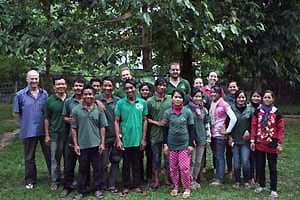 The team on site
The team on site
Since December 2009, the project is managed on site by the German biologist Markus Handschuh (who had been the Collection Manager of ACCB since January 2007) who is supported by the deputy project manager Alistair Mould since March 2010.
The ACCB permanently employs around 20 staff, most of which are Cambodian, in the fields of management, administration and conservation planning, environmental education and sustainable natural resource use, animal keeping, gardening/ site support team, and security. Additionally, temporary staff are hired as required for special projects.
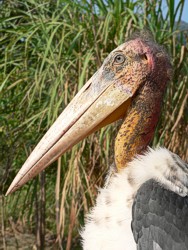 Greater Adjutant (Leptoptilos dubius)
Greater Adjutant (Leptoptilos dubius)The Greater Adjutant is a large stork reaching a body length of 145-150 cm with a wingspan of 250 cm. The plumage is black on the upper side of the wings and body, and whitish or light grey on the lower side. The pink neck and head are bald, adapted to life as a scavenger. Plumage on the head would quickly clog with blood and matter, a bald head is easier to keep clean. The yellow beak is long, thick and strong. Feeding not exclusively on carrion, the bird also eats small amphibians and reptiles. The Greater Adjutant inhabits tropical wetlands in South East Asia, breeding sites are however limited to Assam and Cambodia. The nests are built in trees; a clutch mostly consists of 2-4 eggs. Like other storks the species often forms colonies. Listed by the IUCN as endangered, this bird is mainly endangered by the loss of breeding places and the continuous loss of habitat.
 Lesser Adjutant (Leptoptilos javanicus)
Lesser Adjutant (Leptoptilos javanicus)
Smaller than his relative, the Lesser Adjutant reaches a body length of 110-120 cm with a wingspan of 210 cm. His long, thick and lightly coloured beak is slightly thinner. The plumage is black on the upper side of the wings and body, and light grey on the lower side. In contrast to the Greater Adjutant this species does not have a white ruff at the base of the neck or a large neck pouch. It mainly feeds on fish, but also small amphibians, crustaceans, crickets and small rodents. Loss of breeding sites and the continuous destruction of habitats – tropical wetlands in South East Asia – resulted in this species being listed as vulnerable by the IUCN.
 Water birds
Water birds
Various types of water birds are still common throughout the region and can be found in marshes, paddyfields, lakes, mud flats, pastures and mangroves. The long-legged Egrets and Herons catch fish, crabs and insects by stabbing them with their long pointed bills. Most ducks feed on vegetation in addition to small insects and aquatic organisms.
Different species of water birds, like Asian Openbill (Anastomus oscitans), Cattle Egret (Bubulcus ibis), Black-crowned Night Heron (Nycticorax nycticorax), Little Egret (Egretta garzetta) and Lesser Whistling-Duck (Dendrocygna javanica) are kept in the ACCB. Regularly hunted for human consumption, these birds can often be found for sale in local markets. Large scale hunting has substantially reduced the number of the larger species throughout the region.
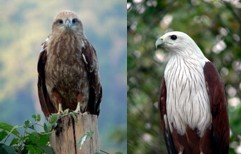 Raptors
Raptors
There are two kinds of raptors in the ACCB: two species of kites, the Crested Serpent Eagle (Spilornes cheela) and the Brahminy Kite (Haliastur Indus), and on the other hand an owl species, the Collared Scops Owl (Otus lettia). Brahminy Kites are up to 50 cm big raptors, which live at rivers, lakes and paddyfields all over Southeast-Asia. They feed on crabs, snakes, fish, frogs, insects and also carrion.
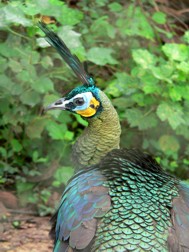 Green Peafowl (Pavo muticus)
Green Peafowl (Pavo muticus)
The Green Peafowl is a large terrestrial bird that prefers open forest habitat such as dry deciduous forest with grassy understoreys and forest edges along ponds or rivers. In these habitats it can find its preferred foods of grain, seeds, shoots, buds, leaves, fruits, insects, frogs and lizards. Cambodia is one of the last strongholds of this species in the world. The status of the Green Peafowl in the Red List is vulnerable. The species’ decline is due to habitat destruction and hunting for their beautiful feathers, the birds themselves which are kept as pets, and their eggs.
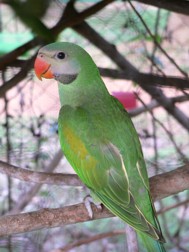 Further bird species kept at the ACCB
Further bird species kept at the ACCB
Furthermore, another bird species is kept in the ACCB, the Red-breasted Parakeet (Psittacula alexandri). This species is divided into seven sub-species and widely distributed over Southeast-Asia. These birds often live in the vicinity of human settlements and in parks and feed on fruits, nuts, buds and leaves.
This post is credited to ACCB, the Angkor Center for Conservation of Biodiversity..Please support ACCB so that we can protect the birds in Cambodia!!!
Other sites you may want to see:
Entertainment on Flixya: http://visalittleboy.flixya.com/
WWE: http://visa-wwe.blogspot.com/
The Kingdom of Wonder: http://welcome2cambodia.blogspot.com/
Daily Blogging: http://visablogging.blogspot.com/
Love Sharing: http://visa-love.blogspot.com/
NetworkSecurity: http://networksecuritynotes.blogspot.com/
About Insurance:http://visa-insurance.blogspot.com
All about Love: http://visa-love.blogspot.com/
Learning English Online: http://visa-elb.blogspot.com/
Discovery Internet: http://visa-isp.blogspot.com/















0 comments:
Post a Comment